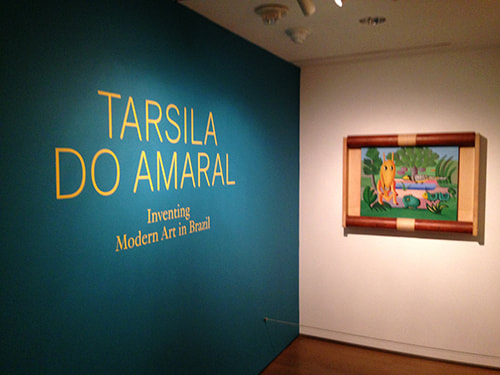|
“Tarsila do Amaral: Inventing Modern Art in Brazil” at the Museum of Modern Art presents the work of the artist who led the development of the modernist movement in Brazil. During the 1920s, Tarsila, as she is widely known in Brazil, developed a distinctive style that was truly Brazilian. MOMA has assembled over 100 works drawn from various collections including some of her landmark paintings to document this development.
Tarsila was born in Capivari, a small town near Sao Paulo, Brazil in 1886. Her family owned coffee plantations. Although it was unusual at that time for girls from affluent families to pursue higher education, Tarsilia was allowed to pursue her interest in art, both in Brazil and in Barcelona, Spain. Her instructors were conservative, academic artists. In 1920, after the end of her first marriage, Tarsila went to Paris in 1920 to study at the prestigious Academie Julian. Her studies were again in the academic tradition. Meanwhile, a modern art movement had taken root in Brazil. The landmark Semana de Arte Moderna was a festival that called for an end to academic art. Upon Tarsila's return to Brazil, she discovered modern art became a leader in this movement, one of the five artists and writers in the Grupo dos Cincos. In 1922, she returned to Paris and studied with several Cubist artists including Ferdinand Leger and Andre Lehote. However, she continued to think in terms of Brazil. She painted “A Negra,” an abstract portrait of an Afro-Brazilian woman. Returning to Brazil, she embarked upon a tour around the country. The drawings of the countryside and everyday life she made while on this journey served as inspiration for later paintings. Her traveling companion was the writer Oswald de Andrade wrote a manifesto “Pau-Brasil” calling for truly Brazilian culture. She married Andrade in 1926. Tarsila made another journey to Paris in 1928 where she came into contact with surrealist art. (It should be noted that Tarsila did not live like a starving artist in Paris. A renown beauty from a wealthy family, she lived a lavish lifestyle, mixing with famous personalities, artists, writers and intellectuals). That same year, she painted “Abaporu” (the man who eats human flesh) as a birthday present for her husband. He used the image for the cover of his “Manifesto of Anthropology,” which called upon artists to cannibalize European culture and other influences in order to create a distinctive Brazilian culture. The painting and the manifesto are considered landmarks in the development of Brazilian culture. Tarsila's family fortune was all but lost as a result of The New York Stock Exchange crash of 1929 and the following Depression. Her marriage to Andrade ended the following year. In 1931, Tarsila traveled to Moscow with her new boyfriend, a communist doctor. There she was influenced by Socialist Realism. Her subsequent work was primarily concerned with social issues. The exhibition at MOMA focuses on the decade beginning with her journey to Paris in 1920. It demonstrates how Tarsila's work evolved incorporating over time elements of Cubism, Brazilian folk art and Surrealism while retaining her own style. Although she was influenced by each of these schools, she did not become part of them. Hers is a distinctive style: flat two dimensional; populated with simplified, distorted figures and landscapes; often with geometric backgrounds. It is also clearly Brazilian, not only in the choice of subject matter but in the selection of colors. In short, it is what Andrade was calling for - - a synthesis of a number of influences producing a truly Brazilian art. The exhibit also includes some works after her trip to Russia. “The Workers” (1933) was one of the first paintings in Brazil dealing with social issues. It reflects the influence of Soviet painting both in subject matter and palette. Incorporation of this soulless style was not a happy addition to Tarsila's arsenal. The work does not have the life of her earlier works and the treatment of the subject matter is much like what numerous other artists were doing at the time. However, it does serve to spotlight how special her work was during the preceding decade. Comments are closed.
|
AuthorRich Wagner is a writer, photographer and artist. Archives
November 2018
Categories
All
|

 RSS Feed
RSS Feed